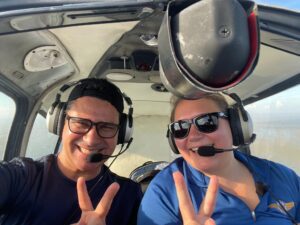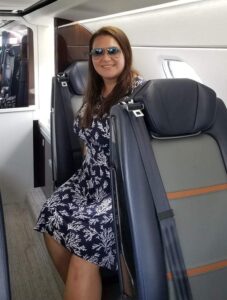 Private air charter has many challenges ahead. Pictured above is one of our Managing Partners, Katherine Koch, my darling wife and future commercial ATP pilot. Unfortunately she only represents a small number of future commercial pilots headed towards the private air charter industry or a major commercial airlines. The pilot shortage is private aviation’s number one challenge, further exacerbated by competition for pilots from airline and freight operations. The airlines are offering huge sign-on bonuses, great work schedules, amazing benefits packages, and lofty annual salaries particularly for anyone experienced enough to graduate to the left seat of these jets. After forcing early retirements during the pandemic, the majors are desperately playing catch-up in this highly competitive industry. Upward mobility was already accelerated before the pandemic but now in the aftermath pilots are upgrading at minimums and jumping from regional to major airlines with unprecedented speed. There is a huge presence in aviation schools by most of the regional airlines that feed these major carriers, something we are not seeing enough of by the private air charter industry. It is a major challenge among many others we will discuss further in this article. In this article, we will take a quick look back 5 years ago at the challenges to private air charter that have shaped the current industry. In next week’s post, we will take a deeper dive into the current private air charter industry.
Private air charter has many challenges ahead. Pictured above is one of our Managing Partners, Katherine Koch, my darling wife and future commercial ATP pilot. Unfortunately she only represents a small number of future commercial pilots headed towards the private air charter industry or a major commercial airlines. The pilot shortage is private aviation’s number one challenge, further exacerbated by competition for pilots from airline and freight operations. The airlines are offering huge sign-on bonuses, great work schedules, amazing benefits packages, and lofty annual salaries particularly for anyone experienced enough to graduate to the left seat of these jets. After forcing early retirements during the pandemic, the majors are desperately playing catch-up in this highly competitive industry. Upward mobility was already accelerated before the pandemic but now in the aftermath pilots are upgrading at minimums and jumping from regional to major airlines with unprecedented speed. There is a huge presence in aviation schools by most of the regional airlines that feed these major carriers, something we are not seeing enough of by the private air charter industry. It is a major challenge among many others we will discuss further in this article. In this article, we will take a quick look back 5 years ago at the challenges to private air charter that have shaped the current industry. In next week’s post, we will take a deeper dive into the current private air charter industry.
The private jet charter business had its fair share of problems like any other industry five years ago. Staffing was an issue but not to the extent it is today. Other factors overshadowed the issue back then. A lot of air charter companies didn’t have enough foresight and planning skills. Many wound up with negative budgets by spending way more than they were taking in. Debt had a way of getting out of control especially when the tempting business and lucrative opportunities of private jets blinded many before it was too late. Lawsuits from unhappy flyers, ex-employees, competing companies, and even the government were also mounting. Lawsuits can easily ground even the best private aviation organizations. Even airports caused operators location issues as many towers lost their funding and were decommissioned or were under pressure from localities looking to take the land and develop it for housing.
Further, it is easy to see the operational inefficiencies of the management of emptylegs. Many flyers don’t even know what an emptyleg is, and, worse, are often unaware they are paying for them. For example, let’s say a flyer is in New York with a business need in Chicago but the operator’s plane is in Houston. The plane first has to be flown from Texas to New York most likely empty. Then the plane picks up the passengers to bring them to Chicago, but the flyer isn’t leaving anytime soon because they are in town for a business conference. For many reasons the plane and crew may have to go back to the home base and depending on demand may be flown back to Texas empty without passengers. Guess who pays for all that flying? You got it: most of the time its the flyer who booked the flight! What the flyer sees as one flight from New York to Chicago may actually be three flights. Add in a broker fee, flight card membership, et cetera, and you’re looking at footing a pretty large bill. Sometimes operators have to absorb the costs of of the empties, cutting into their margins. With this simple example, you can see how inefficient and complex the business can be. Keep in mind this was the common structure five years ago and there are many new aspects to this “empty flying” we will discuss in our current look at the industry next week.
Five years ago, there were all kinds of new apps that were funded by all types of investors. Some of these investors are famous and some are very rich and influential. Memberships with those companies and cost of flights had nothing to do with actual costs and profit margins. Some operators intentionally operated at a loss for the sake of customer acquisition, particularly for influencer types of flyers. Investor money covered the differences (losses) as the invested parties wagered for a huge IPO in the future in hopes of reaping a bigger ROI. Unfortunately, that often didn’t happen. Wall Street loves revenue, profits, and earnings per share, something these apps and operators had no way of showing. Add in fluctuating fuel prices that made planning and forecasting impossible; operators often have little power over fuel prices and can get caught in the crosshairs of government policies. Many of these operators agreed to fixed hourlies to get clients for these new apps, cutting their margins and making them ripe for failure. Adding in rising insurance costs and the overall expenses from the certification process to make an operator a FAA 135 compliant operator, many operators were headed to bankruptcy court or being purchased by larger operators. This trend of consolidation really started in the last five years and we are seeing it continue today. Back then many operators were inefficient in the overall day to day operations of their charter businesses and positioned themselves for takeover bid or overall failure of the business.
It truly has brought us to this point today and the writing is on the wall for this upcoming year. With the realities of recession, production delays due to supply chain issues, and many aspects of our industry we will touch on next week, it is clear that what we do today will shape the future of the private air charter industry. There is a lot of opportunity, and many large private air charter operations are well positioned for dominance, but this industry’s growth potential still dwarfs the number of players on the field, leaving more cake than crumbs for the smart operator and people serving them.
The Japanese have a concept called Kaizen referring to business activities that continuously improve all functions and involve all employees from the CEO to the assembly line workers. Kaizen also applies to processes, such as purchasing and logistics, that cross organizational boundaries into the supply chain. It is something the industry needs to embrace and we will explore this too next week.
Until then, Be Social, Fly Private ! Sign Up Today! Follow us on Instagram Follow us on Facebook


 Private air charter has many challenges ahead. Pictured above is one of our Managing Partners, Katherine Koch, my darling wife and future commercial ATP pilot. Unfortunately she only represents a small number of future commercial pilots headed towards the private air charter industry or a major commercial airlines. The pilot shortage is private aviation’s number one challenge, further exacerbated by competition for pilots from airline and freight operations. The airlines are offering huge sign-on bonuses, great work schedules, amazing benefits packages, and lofty annual salaries particularly for anyone experienced enough to graduate to the left seat of these jets. After forcing early retirements during the pandemic, the majors are desperately playing catch-up in this highly competitive industry. Upward mobility was already accelerated before the pandemic but now in the aftermath pilots are upgrading at minimums and jumping from regional to major airlines with unprecedented speed. There is a huge presence in aviation schools by most of the regional airlines that feed these major carriers, something we are not seeing enough of by the private air charter industry. It is a major challenge among many others we will discuss further in this article. In this article, we will take a quick look back 5 years ago at the challenges to private air charter that have shaped the current industry. In next week’s post, we will take a deeper dive into the current private air charter industry.
Private air charter has many challenges ahead. Pictured above is one of our Managing Partners, Katherine Koch, my darling wife and future commercial ATP pilot. Unfortunately she only represents a small number of future commercial pilots headed towards the private air charter industry or a major commercial airlines. The pilot shortage is private aviation’s number one challenge, further exacerbated by competition for pilots from airline and freight operations. The airlines are offering huge sign-on bonuses, great work schedules, amazing benefits packages, and lofty annual salaries particularly for anyone experienced enough to graduate to the left seat of these jets. After forcing early retirements during the pandemic, the majors are desperately playing catch-up in this highly competitive industry. Upward mobility was already accelerated before the pandemic but now in the aftermath pilots are upgrading at minimums and jumping from regional to major airlines with unprecedented speed. There is a huge presence in aviation schools by most of the regional airlines that feed these major carriers, something we are not seeing enough of by the private air charter industry. It is a major challenge among many others we will discuss further in this article. In this article, we will take a quick look back 5 years ago at the challenges to private air charter that have shaped the current industry. In next week’s post, we will take a deeper dive into the current private air charter industry.